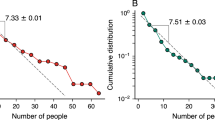Abstract
The paper presents a modified model of the interaction between corrupt power hierarchies and civil society. The suggested improvements and generalizations consist of more comprehensively defining the damage from corruption and the value of suppressing corruption that are more coherent with the considered phenomenon, and the different types of bureaucratic reactions to anticorruption policies, as well as setting the boundary conditions for the model’s equations, are considered. The modified model serves as a base for computing the relative efficiency of different anticorruption strategies for hierarchies of different topologies and behaviors, taking into account the intensity of the influence of civil society on government bodies and agencies. It is found that, based on the assumptions of this model, suppressing corruption among the low-ranked bureaucrats in weakly branched hierarchies and among high-ranked bureaucrats among strongly branched hierarchies are the most efficient strategies. At the same time, strongly centralized hierarchies are the most sensitive to the choice of anticorruption strategies. In addition, it is shown that the suppression of senior bureaucrats is more efficient for more irresponsible hierarchies, whereas the suppression of low-ranked bureaucrats is most efficient for hierarchies with a relatively strong influence of civil society on power distribution. A brief comparison of the traditional approach to the mathematical investigation of corruption, using the game-theoretic model, with the systemic-social approach presented in the current and earlier papers, is also given.
Similar content being viewed by others
References
S. Rose-Ackerman, “The economics of corruption,” J. Public Econ. 4, 187–203 (1975).
International Handbook on the Economics of Corruption, Ed. by S. Rose-Ackerman (Elgar, Edward, 2007).
P. Mauro, “Corruption and growth,” Quart. J. Econ., 681–712 (1995).
S. Guriev, “Red tape and corruption,” J. Develop. Econ. 73, 489–504 (2004).
J. Tirole, “Hierarchies and bureaucracies: on the role of collusion in organizations,” J. Law, Econ. Organ. 2, 181–214 (1986).
G. A. Ugol’nitskii and A. B. Usov, “Models of fight against administrative corruption in hierarchical control systems,” Mat. Teor. Igr Prilozh. 6 (1), 73–90 (2014).
A. Mishra, “Hierarchies, incentives and collusion in a model of enforcement,” J. Econ. Behavior Organ. 47, 165–178 (2002).
M. Bac, “Corruption, supervision, and the structure of hierarchies,” J. Law, Econ. Organ. 12, 277–298 (1996).
P. K. Bag, “Controlling corruption in hierarchies,” J. Compar. Econ. 25, 322–344 (1997).
A. A. Vasin, P. A. Kartunova, and A. S. Urazov, “Models for the organization of state inspections and the struggle against corruption,” Math. Models Comput. Simul. 2, 760–775 (2010).
A. Shleifer and R. W. Vishny, “Corruption,” Quart. J. Econ. 108, 599–617 (1993).
A. Mishra, “Corruption, hierarchies and bureaucratic structure,” in International Handbook on the Economics of Corruption, Ed. by S. Rose-Ackerman (Edward Elgar, Cheltenham, UK, 2007).
A. P. Mikhailov, “Efficient strategies of corruption suppression in state power hierarchies,” in Proceedings of 15th IMACS World Congress on Scientific Computation, Modelling and Applied Mathematics, Berlin, Germany, August 24–29, 1997, Vol. 3, pp. 727–733.
A. P. Mikhailov, “The model of corrupt power hierarchies,” Mat. Model. 11 (1), 3–19 (1999).
M. Levin and G. Sataro, “Corruption in Russia: classification and dynamics,” Vopr. Ekon., No. 10, 4–29 (2012).
D. A. Zenyuk, G. G. Malinetskii, and D. S. Faller, “A social model of corruption in hierarchical structures,” KIAM Preprint No. 87 (Keldysh Inst. Appl. Math., Moscow, 2013).
A. P. Mikhailov, “Mathematical modeling of power distribution in state hierarchical structures interacting with civil society,” in Proceedings of the 14th IMACS World Congress on Scientific Computation, Modelling and Applied Mathematics, Atlanta, USA, 1994, Vol. 2, pp. 831–834.
A. A. Samarskii and A. P. Mikhailov, Principles of Mathematical Modeling. Ideas, Methods, Examples (Nauka, Moscow, 1997; Taylor and Francis, London, New York, 2002).
A. P. Mikhailov, Modeling of Authority–Society System (Fizmatlit, Moscow, 2006) [in Russian].
A. Banerjee, S. Mullainathan, and T. Hanna, “Corruption,” No. w17968 (Natl. Bureau of Econ. Res., 2012).
A. P. Mikhailov, E. A. Gorbatikov, and E. D. Kornilina, “A system-social approach to the modeling of corruption,” Mediterran. J. Soc. Sci. 4, 332–342 (2013).
A. P. Mikhailov and D. F. Lankin, “The modelling of optimal strategies of corrupt suppression,” Mat. Model. 18 (12), 115–124 (2006).
Yu. A. Klokov and A. P. Mikhailov, “About one boundary problem of Neumann for the integro-differential equation,” Differ. Uravn. 32, 1110–1113 (1996).
Yu. A. Klokov and A. P. Mikhailov, “Boundary-value problems for ordinary integro-differential equation,” Mat. Model. 9 (7), 93–99 (1997).
M. G. Dmitriev, G. S. Zhukova, and A. P. Petrov, “Asymptotic analysis of the “authority–society” model in case of two stable authority profiles,” Mat. Model. 16 (5), 23–34 (2004).
A. P. Mikhailov and A. V. Savel’ev, “The proof of power structures macromodels by means of their microdescriptions,” Mat. Model. 13 (4), 19–34 (2001).
A. A. Samarskii, The Theory of Difference Schemes (Nauka, Moscow, 1989; Marcel Dekker, New York, Basel, 2001), p. 761.
Author information
Authors and Affiliations
Corresponding author
Additional information
Original Russian Text © A.P. Mikhailov, E.A. Gorbatikov, 2016, published in Matematicheskoe Modelirovanie, 2016, Vol. 28, No. 5, pp. 47–68.
Rights and permissions
About this article
Cite this article
Mikhailov, A.P., Gorbatikov, E.A. Analysis of anticorruption strategies in a modified Power–Society model. Math Models Comput Simul 8, 709–724 (2016). https://doi.org/10.1134/S2070048216060132
Received:
Published:
Issue Date:
DOI: https://doi.org/10.1134/S2070048216060132




